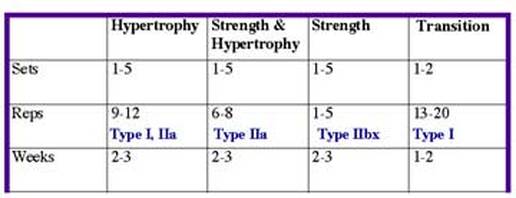Understanding neuromuscular adaptation and maximizing the training effect through periodization10/25/2016 You just completed a workout and you cannot believe it. It has been three long months since you began your journey into the iron paradise. You worked your way up to five days a week at the gym and a couple protein shakes per day and you cannot believe the results you are noticing and the progress you have made. However, another month or two go by and before you know it your progress slows to a halt as you advance past your first six months in the gym. It is a harsh reality to face at first, but you are learning what every advanced lifter, athlete, and strength and conditioning coach has learned at some point. The idea of neuromuscular adaptation is simple enough to understand. Your body undergoes functional and structural changes as a result of strength training. This process is responsible for your ability to gradually handle more weight on the barbell, more minutes of cardiovascular activity, and an overall increase in volume and intensity. It is also responsible for muscle growth (the holy grail), and improvements to the central nervous system. Do not be discouraged. I am going to explain the idea of periodization, introduce methods to vary and introduce several different stimuli, and give you sample repetition ranges to deal with adaptation.
Periodization Periodization is the idea of cycling various methods of training for a specific time in order to efficiently achieve certain goals. For athletes periodization is key in ensuring that peak performance occurs during the most important time of yearly competition. For the average gym goer, periodization can more simply be thought of as an altering of several factors, but most specifically set and repetitions structures. The reason most lifters have a problem with limited gains after a certain period of time is because they do not effectively shift from one method of training to others often enough. Think of this concept as if you were buying a new pair of shoes. At first, the shoes are rugged and uncomfortable and need to be broken in. Think of that time when your training really pushes you and demands extreme amounts of energy from your body. Eventually, you settle in and break these shoes in. The shoes are ready for peak performance, and you excel. Sooner or later these shoes wear out and you no longer get the same results. This is the same as your training! You have become overly accustomed to a certain routine and as a result you have become “overly broken in,” to this training. It is time to use a new pair of shoes for a while! As I will later explain, you must alter your sets and reps, exercises, change the amount of resistance you are using, use differing bar speeds, and make changes to your rest periods and overall volume. Introducing New Stimuli Aside from adjusting your number of sets and repetitions alone, there are three main stimuli that can be altered in order to deal with adaptation. I am not going to count this as one of the three because I feel that it is obvious, but I will address it just to be safe. One of the easiest ways to deal with adaptation is to introduce new exercises into your routine. For example, if you are training strictly for the purpose of hypertrophy and aesthetics, different exercises can target musculature differently and change ranges of motion, and doing that alone can stimulate growth. Let’s say for arguments sake that you have been barbell bench-pressing on your chest days for a couple months. Switching to a dumbbell bench press can target each side of your chest individually and spark more growth. Or, you simply change the grip on your barbell bench press and this will provide the slightest tweak in your range of motion and the path of your arms through flexion and extension. Not only will this be beneficial to a lifter with bodybuilding and aesthetic aspirations, but it will also benefit a performance-oriented athlete. Teaching the body to acquire the necessary motor skills and stability and mobility with different movements is key to improving performance and more sports specific functional training methods. Being able to load your spine and maintain it in a neutral position through various ranges of motion will be critical for your continued development as an athlete. The first way you can introduce stimuli and increase the training effect would be via an increase in the load you are using. It is simple. Slowly increasing the weight you are using can alleviate the negative side effects of advancing adaptations. Basically, by increasing the load you are requesting that your body further grow and become stronger because it will need to in order to handle more weight. You can also place higher demands on your central nervous system with an increased load, which plays a key role in whether or not your body will be able to handle more volume and exertion down the line. Another way to introduce more stimuli is to alter the speed of the bar during your exercises. This can be beneficial to both bodybuilders and athletes when it comes to the training effect. Want to increase your time under tension and build muscle? Slow the bar down during the eccentric (negative) portion of the movement and doing so will increase how long a muscle is held in a contraction and it will be driven to grow. Want to develop power as an athlete? Focus on maintaining the fastest possible bar speed through the concentric portion of the lift and you will most definitely develop power. Lastly, you can adjust your rest periods and your total volume. Lifting heavier for a minimal number of repetitions? Your rest periods will undoubtedly be longer. Lifting lighter with far more repetitions? Than your recovery time will surely be far less. In terms of volume, let me first explain what volume actually is. Volume is a product of your sets, repetitions, and time under tension (think about when I discussed bar speed). Making even minuscule changes to this formula can be enough to bring about an additional training effect. Sample Repetition Ranges Here are some repetition ranges and their corresponding goals. Basically, if you want to achieve a certain goal you can match it with these rep ranges. Also, rotating through these different rep schemes every several weeks can be a great way to not only achieve different results but also deal with adaptations and ensuring that you always get the best possible training effect. Hypertrophy (muscle mass)
Strength
Relative Strength
Muscular Endurance
Now, go continue to make gains and reach your performance goals while managing the limitation of adaptations! Every day presents a new way for you to challenge yourself!
0 Comments
Leave a Reply. |
AuthorSGerry DeFilippo: ISSA CPT- CPPS, AAPS. Founder/Owner: Challenger Strength. Archives
October 2020
Categories
All
|


 RSS Feed
RSS Feed